Annotated Bibliography: Operational Efficiency in Supply Chain
VerifiedAdded on 2023/04/21
|8
|2515
|55
Annotated Bibliography
AI Summary
This annotated bibliography reviews five articles focused on operational efficiency within sustainable supply chain management. The articles explore various aspects, including the relationship between Environmental Management Systems (EMS) and Green Supply Chain Management (GSCM), the application of a bio-inspired Physarum solver for sustainable supply chain network design, the role of supply chain management in supporting end-to-end value chains, research opportunities in supply chain management, and a meta-analysis of environmentally sustainable supply chain practices. The bibliography highlights key findings from each article, such as the importance of organizational capabilities for implementing EMS and GSCM, the application of the Physarum model for network optimization, the integration of sustainability dimensions, and the factors influencing firm performance in sustainable supply chains. The overall aim is to provide insights into the practices organizations should adopt to fulfill corporate social responsibility within their supply chains.

RUNNING HEAD: Supply chain 0
Supply chain
Supply chain
Paraphrase This Document
Need a fresh take? Get an instant paraphrase of this document with our AI Paraphraser
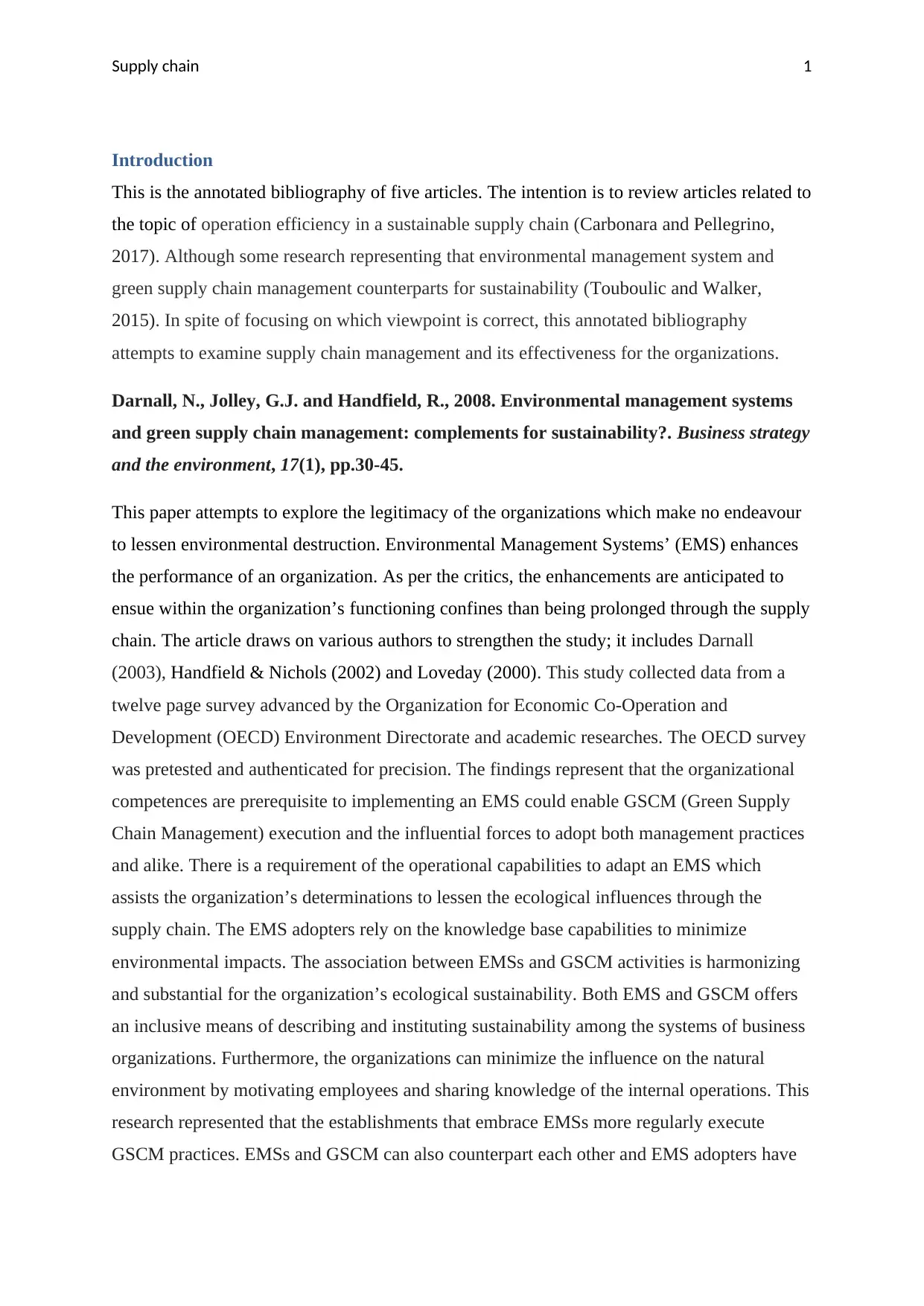
Supply chain 1
Introduction
This is the annotated bibliography of five articles. The intention is to review articles related to
the topic of operation efficiency in a sustainable supply chain (Carbonara and Pellegrino,
2017). Although some research representing that environmental management system and
green supply chain management counterparts for sustainability (Touboulic and Walker,
2015). In spite of focusing on which viewpoint is correct, this annotated bibliography
attempts to examine supply chain management and its effectiveness for the organizations.
Darnall, N., Jolley, G.J. and Handfield, R., 2008. Environmental management systems
and green supply chain management: complements for sustainability?. Business strategy
and the environment, 17(1), pp.30-45.
This paper attempts to explore the legitimacy of the organizations which make no endeavour
to lessen environmental destruction. Environmental Management Systems’ (EMS) enhances
the performance of an organization. As per the critics, the enhancements are anticipated to
ensue within the organization’s functioning confines than being prolonged through the supply
chain. The article draws on various authors to strengthen the study; it includes Darnall
(2003), Handfield & Nichols (2002) and Loveday (2000). This study collected data from a
twelve page survey advanced by the Organization for Economic Co-Operation and
Development (OECD) Environment Directorate and academic researches. The OECD survey
was pretested and authenticated for precision. The findings represent that the organizational
competences are prerequisite to implementing an EMS could enable GSCM (Green Supply
Chain Management) execution and the influential forces to adopt both management practices
and alike. There is a requirement of the operational capabilities to adapt an EMS which
assists the organization’s determinations to lessen the ecological influences through the
supply chain. The EMS adopters rely on the knowledge base capabilities to minimize
environmental impacts. The association between EMSs and GSCM activities is harmonizing
and substantial for the organization’s ecological sustainability. Both EMS and GSCM offers
an inclusive means of describing and instituting sustainability among the systems of business
organizations. Furthermore, the organizations can minimize the influence on the natural
environment by motivating employees and sharing knowledge of the internal operations. This
research represented that the establishments that embrace EMSs more regularly execute
GSCM practices. EMSs and GSCM can also counterpart each other and EMS adopters have
Introduction
This is the annotated bibliography of five articles. The intention is to review articles related to
the topic of operation efficiency in a sustainable supply chain (Carbonara and Pellegrino,
2017). Although some research representing that environmental management system and
green supply chain management counterparts for sustainability (Touboulic and Walker,
2015). In spite of focusing on which viewpoint is correct, this annotated bibliography
attempts to examine supply chain management and its effectiveness for the organizations.
Darnall, N., Jolley, G.J. and Handfield, R., 2008. Environmental management systems
and green supply chain management: complements for sustainability?. Business strategy
and the environment, 17(1), pp.30-45.
This paper attempts to explore the legitimacy of the organizations which make no endeavour
to lessen environmental destruction. Environmental Management Systems’ (EMS) enhances
the performance of an organization. As per the critics, the enhancements are anticipated to
ensue within the organization’s functioning confines than being prolonged through the supply
chain. The article draws on various authors to strengthen the study; it includes Darnall
(2003), Handfield & Nichols (2002) and Loveday (2000). This study collected data from a
twelve page survey advanced by the Organization for Economic Co-Operation and
Development (OECD) Environment Directorate and academic researches. The OECD survey
was pretested and authenticated for precision. The findings represent that the organizational
competences are prerequisite to implementing an EMS could enable GSCM (Green Supply
Chain Management) execution and the influential forces to adopt both management practices
and alike. There is a requirement of the operational capabilities to adapt an EMS which
assists the organization’s determinations to lessen the ecological influences through the
supply chain. The EMS adopters rely on the knowledge base capabilities to minimize
environmental impacts. The association between EMSs and GSCM activities is harmonizing
and substantial for the organization’s ecological sustainability. Both EMS and GSCM offers
an inclusive means of describing and instituting sustainability among the systems of business
organizations. Furthermore, the organizations can minimize the influence on the natural
environment by motivating employees and sharing knowledge of the internal operations. This
research represented that the establishments that embrace EMSs more regularly execute
GSCM practices. EMSs and GSCM can also counterpart each other and EMS adopters have
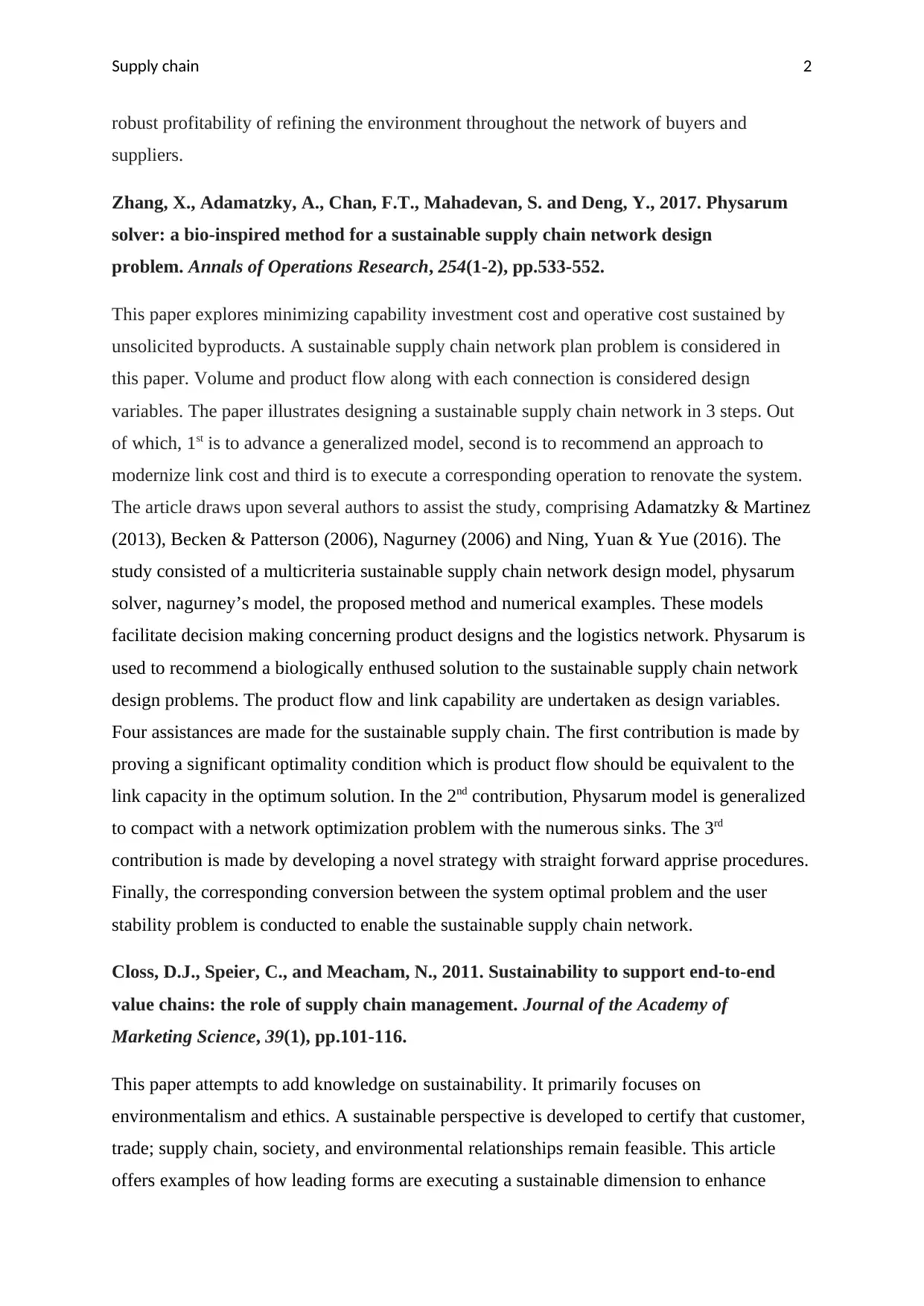
Supply chain 2
robust profitability of refining the environment throughout the network of buyers and
suppliers.
Zhang, X., Adamatzky, A., Chan, F.T., Mahadevan, S. and Deng, Y., 2017. Physarum
solver: a bio-inspired method for a sustainable supply chain network design
problem. Annals of Operations Research, 254(1-2), pp.533-552.
This paper explores minimizing capability investment cost and operative cost sustained by
unsolicited byproducts. A sustainable supply chain network plan problem is considered in
this paper. Volume and product flow along with each connection is considered design
variables. The paper illustrates designing a sustainable supply chain network in 3 steps. Out
of which, 1st is to advance a generalized model, second is to recommend an approach to
modernize link cost and third is to execute a corresponding operation to renovate the system.
The article draws upon several authors to assist the study, comprising Adamatzky & Martinez
(2013), Becken & Patterson (2006), Nagurney (2006) and Ning, Yuan & Yue (2016). The
study consisted of a multicriteria sustainable supply chain network design model, physarum
solver, nagurney’s model, the proposed method and numerical examples. These models
facilitate decision making concerning product designs and the logistics network. Physarum is
used to recommend a biologically enthused solution to the sustainable supply chain network
design problems. The product flow and link capability are undertaken as design variables.
Four assistances are made for the sustainable supply chain. The first contribution is made by
proving a significant optimality condition which is product flow should be equivalent to the
link capacity in the optimum solution. In the 2nd contribution, Physarum model is generalized
to compact with a network optimization problem with the numerous sinks. The 3rd
contribution is made by developing a novel strategy with straight forward apprise procedures.
Finally, the corresponding conversion between the system optimal problem and the user
stability problem is conducted to enable the sustainable supply chain network.
Closs, D.J., Speier, C., and Meacham, N., 2011. Sustainability to support end-to-end
value chains: the role of supply chain management. Journal of the Academy of
Marketing Science, 39(1), pp.101-116.
This paper attempts to add knowledge on sustainability. It primarily focuses on
environmentalism and ethics. A sustainable perspective is developed to certify that customer,
trade; supply chain, society, and environmental relationships remain feasible. This article
offers examples of how leading forms are executing a sustainable dimension to enhance
robust profitability of refining the environment throughout the network of buyers and
suppliers.
Zhang, X., Adamatzky, A., Chan, F.T., Mahadevan, S. and Deng, Y., 2017. Physarum
solver: a bio-inspired method for a sustainable supply chain network design
problem. Annals of Operations Research, 254(1-2), pp.533-552.
This paper explores minimizing capability investment cost and operative cost sustained by
unsolicited byproducts. A sustainable supply chain network plan problem is considered in
this paper. Volume and product flow along with each connection is considered design
variables. The paper illustrates designing a sustainable supply chain network in 3 steps. Out
of which, 1st is to advance a generalized model, second is to recommend an approach to
modernize link cost and third is to execute a corresponding operation to renovate the system.
The article draws upon several authors to assist the study, comprising Adamatzky & Martinez
(2013), Becken & Patterson (2006), Nagurney (2006) and Ning, Yuan & Yue (2016). The
study consisted of a multicriteria sustainable supply chain network design model, physarum
solver, nagurney’s model, the proposed method and numerical examples. These models
facilitate decision making concerning product designs and the logistics network. Physarum is
used to recommend a biologically enthused solution to the sustainable supply chain network
design problems. The product flow and link capability are undertaken as design variables.
Four assistances are made for the sustainable supply chain. The first contribution is made by
proving a significant optimality condition which is product flow should be equivalent to the
link capacity in the optimum solution. In the 2nd contribution, Physarum model is generalized
to compact with a network optimization problem with the numerous sinks. The 3rd
contribution is made by developing a novel strategy with straight forward apprise procedures.
Finally, the corresponding conversion between the system optimal problem and the user
stability problem is conducted to enable the sustainable supply chain network.
Closs, D.J., Speier, C., and Meacham, N., 2011. Sustainability to support end-to-end
value chains: the role of supply chain management. Journal of the Academy of
Marketing Science, 39(1), pp.101-116.
This paper attempts to add knowledge on sustainability. It primarily focuses on
environmentalism and ethics. A sustainable perspective is developed to certify that customer,
trade; supply chain, society, and environmental relationships remain feasible. This article
offers examples of how leading forms are executing a sustainable dimension to enhance
⊘ This is a preview!⊘
Do you want full access?
Subscribe today to unlock all pages.

Trusted by 1+ million students worldwide
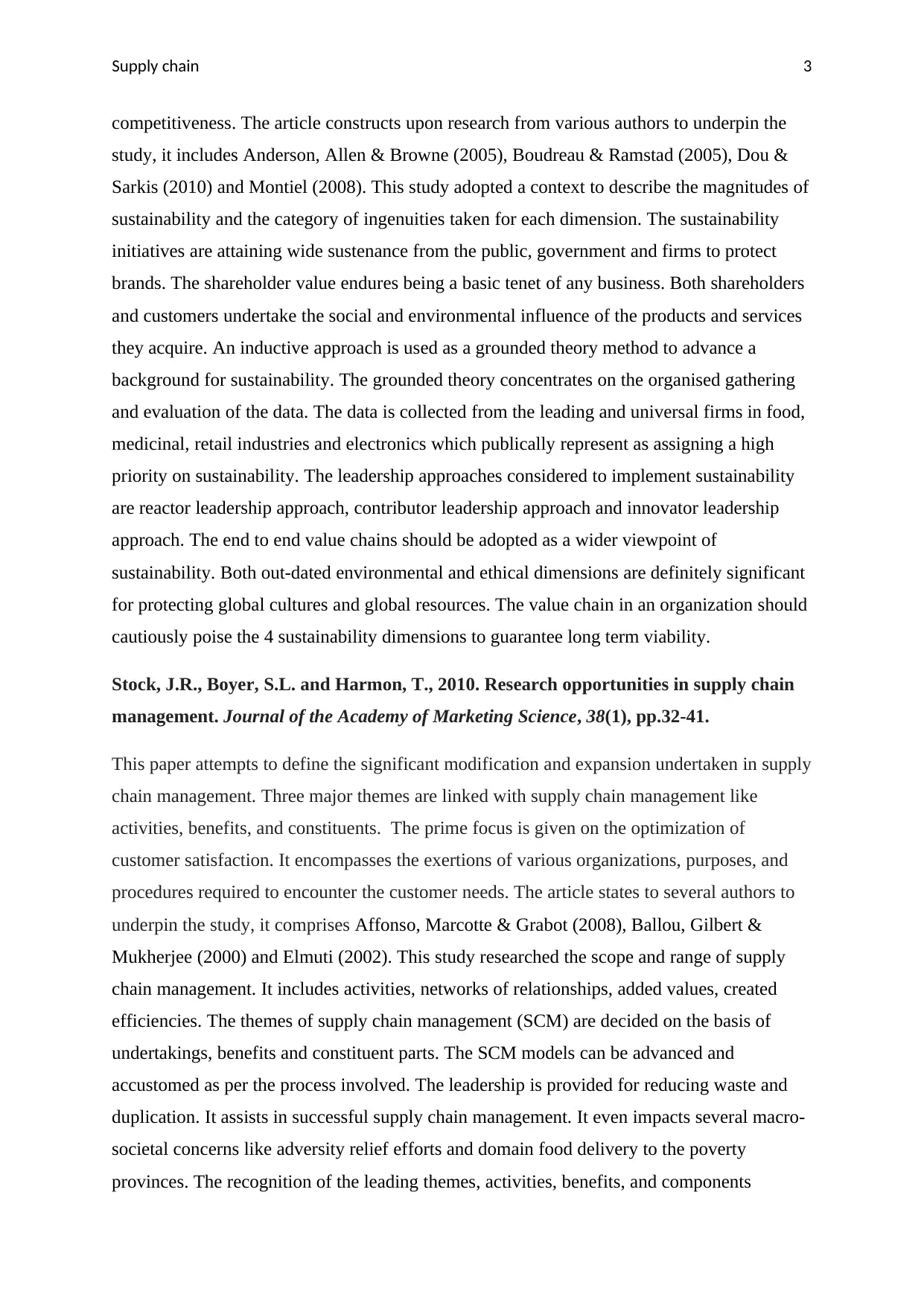
Supply chain 3
competitiveness. The article constructs upon research from various authors to underpin the
study, it includes Anderson, Allen & Browne (2005), Boudreau & Ramstad (2005), Dou &
Sarkis (2010) and Montiel (2008). This study adopted a context to describe the magnitudes of
sustainability and the category of ingenuities taken for each dimension. The sustainability
initiatives are attaining wide sustenance from the public, government and firms to protect
brands. The shareholder value endures being a basic tenet of any business. Both shareholders
and customers undertake the social and environmental influence of the products and services
they acquire. An inductive approach is used as a grounded theory method to advance a
background for sustainability. The grounded theory concentrates on the organised gathering
and evaluation of the data. The data is collected from the leading and universal firms in food,
medicinal, retail industries and electronics which publically represent as assigning a high
priority on sustainability. The leadership approaches considered to implement sustainability
are reactor leadership approach, contributor leadership approach and innovator leadership
approach. The end to end value chains should be adopted as a wider viewpoint of
sustainability. Both out-dated environmental and ethical dimensions are definitely significant
for protecting global cultures and global resources. The value chain in an organization should
cautiously poise the 4 sustainability dimensions to guarantee long term viability.
Stock, J.R., Boyer, S.L. and Harmon, T., 2010. Research opportunities in supply chain
management. Journal of the Academy of Marketing Science, 38(1), pp.32-41.
This paper attempts to define the significant modification and expansion undertaken in supply
chain management. Three major themes are linked with supply chain management like
activities, benefits, and constituents. The prime focus is given on the optimization of
customer satisfaction. It encompasses the exertions of various organizations, purposes, and
procedures required to encounter the customer needs. The article states to several authors to
underpin the study, it comprises Affonso, Marcotte & Grabot (2008), Ballou, Gilbert &
Mukherjee (2000) and Elmuti (2002). This study researched the scope and range of supply
chain management. It includes activities, networks of relationships, added values, created
efficiencies. The themes of supply chain management (SCM) are decided on the basis of
undertakings, benefits and constituent parts. The SCM models can be advanced and
accustomed as per the process involved. The leadership is provided for reducing waste and
duplication. It assists in successful supply chain management. It even impacts several macro-
societal concerns like adversity relief efforts and domain food delivery to the poverty
provinces. The recognition of the leading themes, activities, benefits, and components
competitiveness. The article constructs upon research from various authors to underpin the
study, it includes Anderson, Allen & Browne (2005), Boudreau & Ramstad (2005), Dou &
Sarkis (2010) and Montiel (2008). This study adopted a context to describe the magnitudes of
sustainability and the category of ingenuities taken for each dimension. The sustainability
initiatives are attaining wide sustenance from the public, government and firms to protect
brands. The shareholder value endures being a basic tenet of any business. Both shareholders
and customers undertake the social and environmental influence of the products and services
they acquire. An inductive approach is used as a grounded theory method to advance a
background for sustainability. The grounded theory concentrates on the organised gathering
and evaluation of the data. The data is collected from the leading and universal firms in food,
medicinal, retail industries and electronics which publically represent as assigning a high
priority on sustainability. The leadership approaches considered to implement sustainability
are reactor leadership approach, contributor leadership approach and innovator leadership
approach. The end to end value chains should be adopted as a wider viewpoint of
sustainability. Both out-dated environmental and ethical dimensions are definitely significant
for protecting global cultures and global resources. The value chain in an organization should
cautiously poise the 4 sustainability dimensions to guarantee long term viability.
Stock, J.R., Boyer, S.L. and Harmon, T., 2010. Research opportunities in supply chain
management. Journal of the Academy of Marketing Science, 38(1), pp.32-41.
This paper attempts to define the significant modification and expansion undertaken in supply
chain management. Three major themes are linked with supply chain management like
activities, benefits, and constituents. The prime focus is given on the optimization of
customer satisfaction. It encompasses the exertions of various organizations, purposes, and
procedures required to encounter the customer needs. The article states to several authors to
underpin the study, it comprises Affonso, Marcotte & Grabot (2008), Ballou, Gilbert &
Mukherjee (2000) and Elmuti (2002). This study researched the scope and range of supply
chain management. It includes activities, networks of relationships, added values, created
efficiencies. The themes of supply chain management (SCM) are decided on the basis of
undertakings, benefits and constituent parts. The SCM models can be advanced and
accustomed as per the process involved. The leadership is provided for reducing waste and
duplication. It assists in successful supply chain management. It even impacts several macro-
societal concerns like adversity relief efforts and domain food delivery to the poverty
provinces. The recognition of the leading themes, activities, benefits, and components
Paraphrase This Document
Need a fresh take? Get an instant paraphrase of this document with our AI Paraphraser
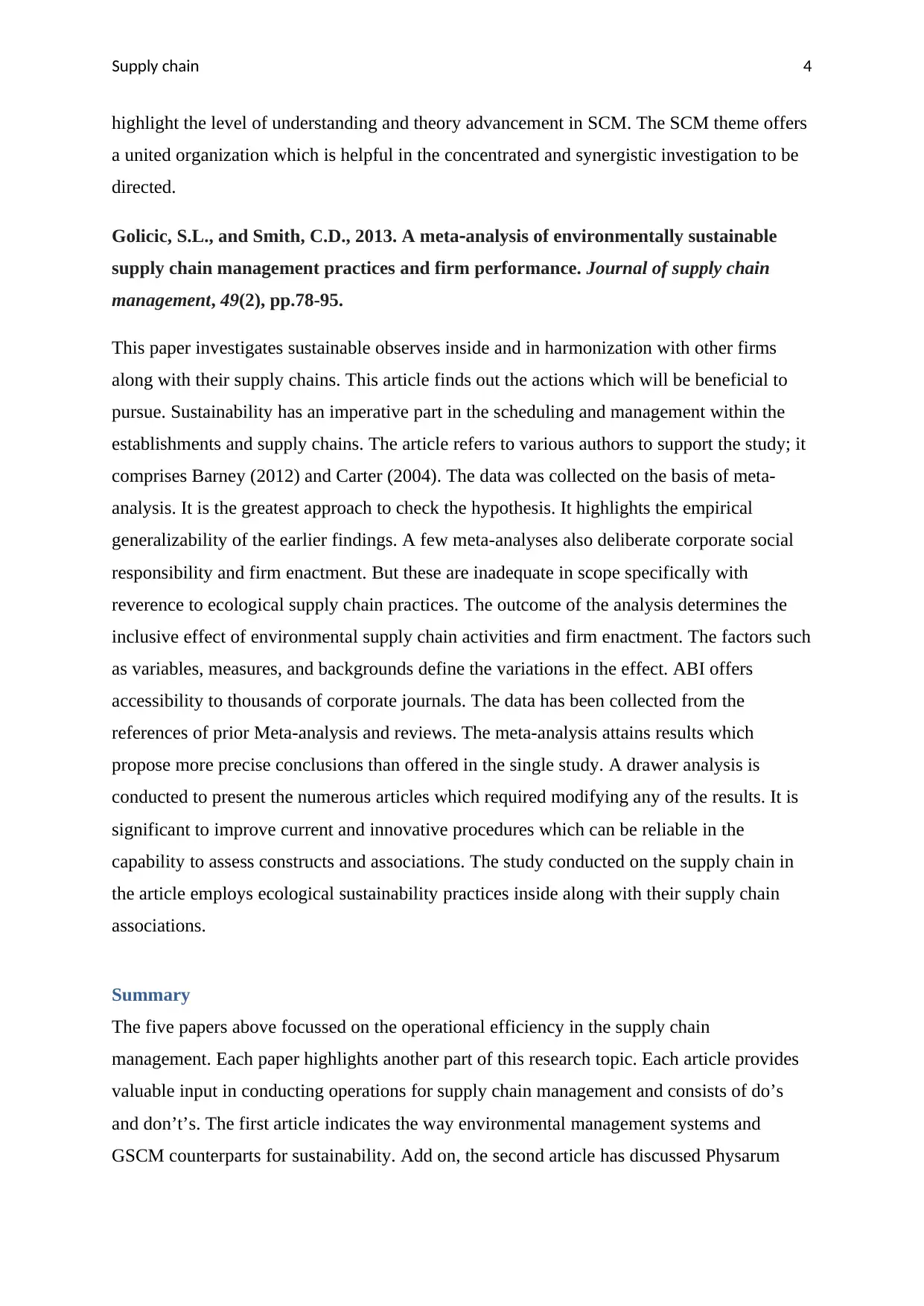
Supply chain 4
highlight the level of understanding and theory advancement in SCM. The SCM theme offers
a united organization which is helpful in the concentrated and synergistic investigation to be
directed.
Golicic, S.L., and Smith, C.D., 2013. A meta‐analysis of environmentally sustainable
supply chain management practices and firm performance. Journal of supply chain
management, 49(2), pp.78-95.
This paper investigates sustainable observes inside and in harmonization with other firms
along with their supply chains. This article finds out the actions which will be beneficial to
pursue. Sustainability has an imperative part in the scheduling and management within the
establishments and supply chains. The article refers to various authors to support the study; it
comprises Barney (2012) and Carter (2004). The data was collected on the basis of meta-
analysis. It is the greatest approach to check the hypothesis. It highlights the empirical
generalizability of the earlier findings. A few meta-analyses also deliberate corporate social
responsibility and firm enactment. But these are inadequate in scope specifically with
reverence to ecological supply chain practices. The outcome of the analysis determines the
inclusive effect of environmental supply chain activities and firm enactment. The factors such
as variables, measures, and backgrounds define the variations in the effect. ABI offers
accessibility to thousands of corporate journals. The data has been collected from the
references of prior Meta-analysis and reviews. The meta-analysis attains results which
propose more precise conclusions than offered in the single study. A drawer analysis is
conducted to present the numerous articles which required modifying any of the results. It is
significant to improve current and innovative procedures which can be reliable in the
capability to assess constructs and associations. The study conducted on the supply chain in
the article employs ecological sustainability practices inside along with their supply chain
associations.
Summary
The five papers above focussed on the operational efficiency in the supply chain
management. Each paper highlights another part of this research topic. Each article provides
valuable input in conducting operations for supply chain management and consists of do’s
and don’t’s. The first article indicates the way environmental management systems and
GSCM counterparts for sustainability. Add on, the second article has discussed Physarum
highlight the level of understanding and theory advancement in SCM. The SCM theme offers
a united organization which is helpful in the concentrated and synergistic investigation to be
directed.
Golicic, S.L., and Smith, C.D., 2013. A meta‐analysis of environmentally sustainable
supply chain management practices and firm performance. Journal of supply chain
management, 49(2), pp.78-95.
This paper investigates sustainable observes inside and in harmonization with other firms
along with their supply chains. This article finds out the actions which will be beneficial to
pursue. Sustainability has an imperative part in the scheduling and management within the
establishments and supply chains. The article refers to various authors to support the study; it
comprises Barney (2012) and Carter (2004). The data was collected on the basis of meta-
analysis. It is the greatest approach to check the hypothesis. It highlights the empirical
generalizability of the earlier findings. A few meta-analyses also deliberate corporate social
responsibility and firm enactment. But these are inadequate in scope specifically with
reverence to ecological supply chain practices. The outcome of the analysis determines the
inclusive effect of environmental supply chain activities and firm enactment. The factors such
as variables, measures, and backgrounds define the variations in the effect. ABI offers
accessibility to thousands of corporate journals. The data has been collected from the
references of prior Meta-analysis and reviews. The meta-analysis attains results which
propose more precise conclusions than offered in the single study. A drawer analysis is
conducted to present the numerous articles which required modifying any of the results. It is
significant to improve current and innovative procedures which can be reliable in the
capability to assess constructs and associations. The study conducted on the supply chain in
the article employs ecological sustainability practices inside along with their supply chain
associations.
Summary
The five papers above focussed on the operational efficiency in the supply chain
management. Each paper highlights another part of this research topic. Each article provides
valuable input in conducting operations for supply chain management and consists of do’s
and don’t’s. The first article indicates the way environmental management systems and
GSCM counterparts for sustainability. Add on, the second article has discussed Physarum

Supply chain 5
solver which is a bio-inspired system for the sustainable supply chain network design
problem. The third article highlights the part of the supply chain management to upkeep an
end to end value chains. Moreover, the fourth article finds out the research prospects in
supply chain management. Finally, the fifth article points out the meta-analysis of
ecologically sustainable supply chain management practices and stable performance.
Inclusive, this annotated bibliography represents the supply chain management practices that
an organization should take to fulfill corporate social responsibility.
solver which is a bio-inspired system for the sustainable supply chain network design
problem. The third article highlights the part of the supply chain management to upkeep an
end to end value chains. Moreover, the fourth article finds out the research prospects in
supply chain management. Finally, the fifth article points out the meta-analysis of
ecologically sustainable supply chain management practices and stable performance.
Inclusive, this annotated bibliography represents the supply chain management practices that
an organization should take to fulfill corporate social responsibility.
⊘ This is a preview!⊘
Do you want full access?
Subscribe today to unlock all pages.

Trusted by 1+ million students worldwide
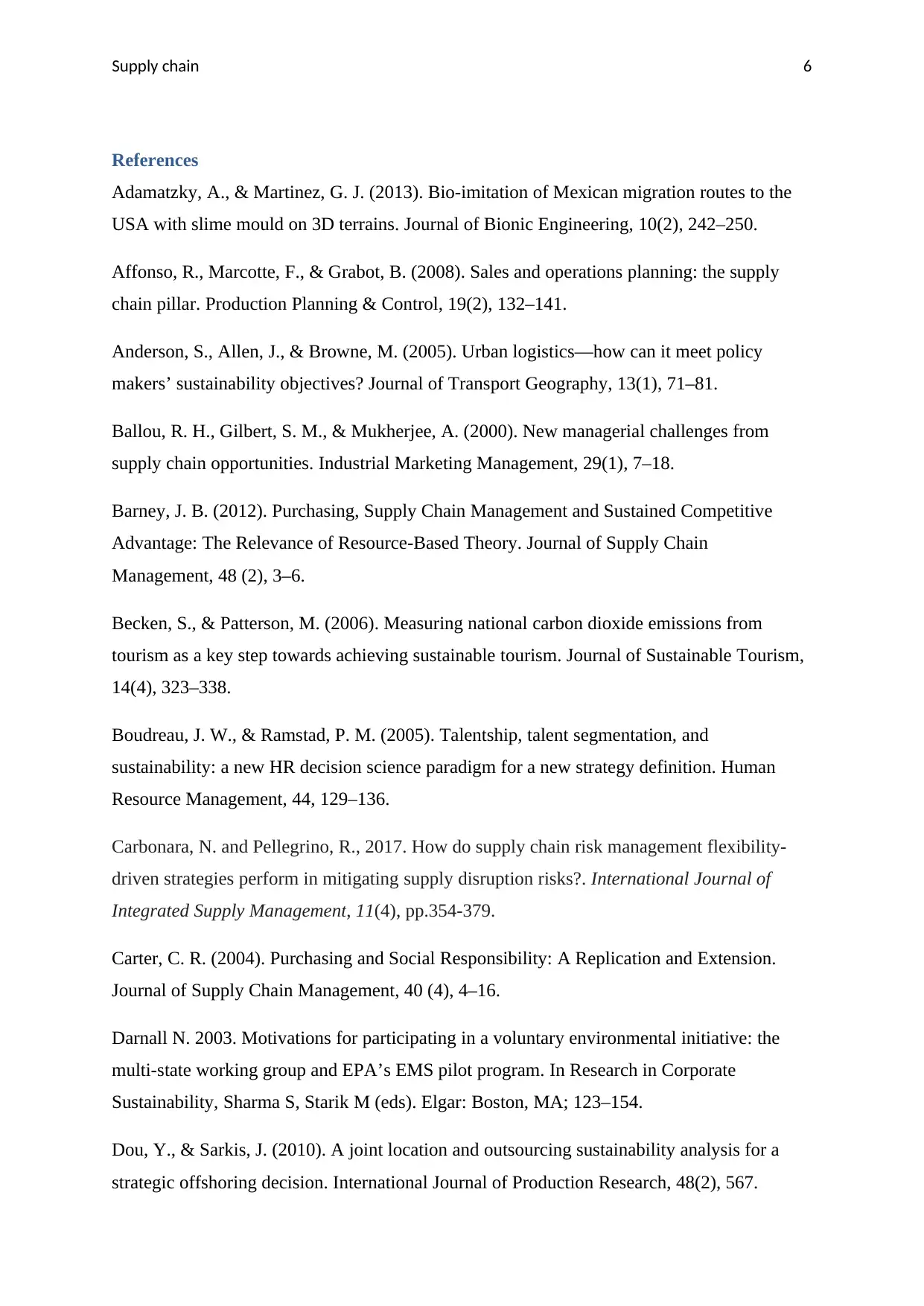
Supply chain 6
References
Adamatzky, A., & Martinez, G. J. (2013). Bio-imitation of Mexican migration routes to the
USA with slime mould on 3D terrains. Journal of Bionic Engineering, 10(2), 242–250.
Affonso, R., Marcotte, F., & Grabot, B. (2008). Sales and operations planning: the supply
chain pillar. Production Planning & Control, 19(2), 132–141.
Anderson, S., Allen, J., & Browne, M. (2005). Urban logistics—how can it meet policy
makers’ sustainability objectives? Journal of Transport Geography, 13(1), 71–81.
Ballou, R. H., Gilbert, S. M., & Mukherjee, A. (2000). New managerial challenges from
supply chain opportunities. Industrial Marketing Management, 29(1), 7–18.
Barney, J. B. (2012). Purchasing, Supply Chain Management and Sustained Competitive
Advantage: The Relevance of Resource-Based Theory. Journal of Supply Chain
Management, 48 (2), 3–6.
Becken, S., & Patterson, M. (2006). Measuring national carbon dioxide emissions from
tourism as a key step towards achieving sustainable tourism. Journal of Sustainable Tourism,
14(4), 323–338.
Boudreau, J. W., & Ramstad, P. M. (2005). Talentship, talent segmentation, and
sustainability: a new HR decision science paradigm for a new strategy definition. Human
Resource Management, 44, 129–136.
Carbonara, N. and Pellegrino, R., 2017. How do supply chain risk management flexibility-
driven strategies perform in mitigating supply disruption risks?. International Journal of
Integrated Supply Management, 11(4), pp.354-379.
Carter, C. R. (2004). Purchasing and Social Responsibility: A Replication and Extension.
Journal of Supply Chain Management, 40 (4), 4–16.
Darnall N. 2003. Motivations for participating in a voluntary environmental initiative: the
multi-state working group and EPA’s EMS pilot program. In Research in Corporate
Sustainability, Sharma S, Starik M (eds). Elgar: Boston, MA; 123–154.
Dou, Y., & Sarkis, J. (2010). A joint location and outsourcing sustainability analysis for a
strategic offshoring decision. International Journal of Production Research, 48(2), 567.
References
Adamatzky, A., & Martinez, G. J. (2013). Bio-imitation of Mexican migration routes to the
USA with slime mould on 3D terrains. Journal of Bionic Engineering, 10(2), 242–250.
Affonso, R., Marcotte, F., & Grabot, B. (2008). Sales and operations planning: the supply
chain pillar. Production Planning & Control, 19(2), 132–141.
Anderson, S., Allen, J., & Browne, M. (2005). Urban logistics—how can it meet policy
makers’ sustainability objectives? Journal of Transport Geography, 13(1), 71–81.
Ballou, R. H., Gilbert, S. M., & Mukherjee, A. (2000). New managerial challenges from
supply chain opportunities. Industrial Marketing Management, 29(1), 7–18.
Barney, J. B. (2012). Purchasing, Supply Chain Management and Sustained Competitive
Advantage: The Relevance of Resource-Based Theory. Journal of Supply Chain
Management, 48 (2), 3–6.
Becken, S., & Patterson, M. (2006). Measuring national carbon dioxide emissions from
tourism as a key step towards achieving sustainable tourism. Journal of Sustainable Tourism,
14(4), 323–338.
Boudreau, J. W., & Ramstad, P. M. (2005). Talentship, talent segmentation, and
sustainability: a new HR decision science paradigm for a new strategy definition. Human
Resource Management, 44, 129–136.
Carbonara, N. and Pellegrino, R., 2017. How do supply chain risk management flexibility-
driven strategies perform in mitigating supply disruption risks?. International Journal of
Integrated Supply Management, 11(4), pp.354-379.
Carter, C. R. (2004). Purchasing and Social Responsibility: A Replication and Extension.
Journal of Supply Chain Management, 40 (4), 4–16.
Darnall N. 2003. Motivations for participating in a voluntary environmental initiative: the
multi-state working group and EPA’s EMS pilot program. In Research in Corporate
Sustainability, Sharma S, Starik M (eds). Elgar: Boston, MA; 123–154.
Dou, Y., & Sarkis, J. (2010). A joint location and outsourcing sustainability analysis for a
strategic offshoring decision. International Journal of Production Research, 48(2), 567.
Paraphrase This Document
Need a fresh take? Get an instant paraphrase of this document with our AI Paraphraser
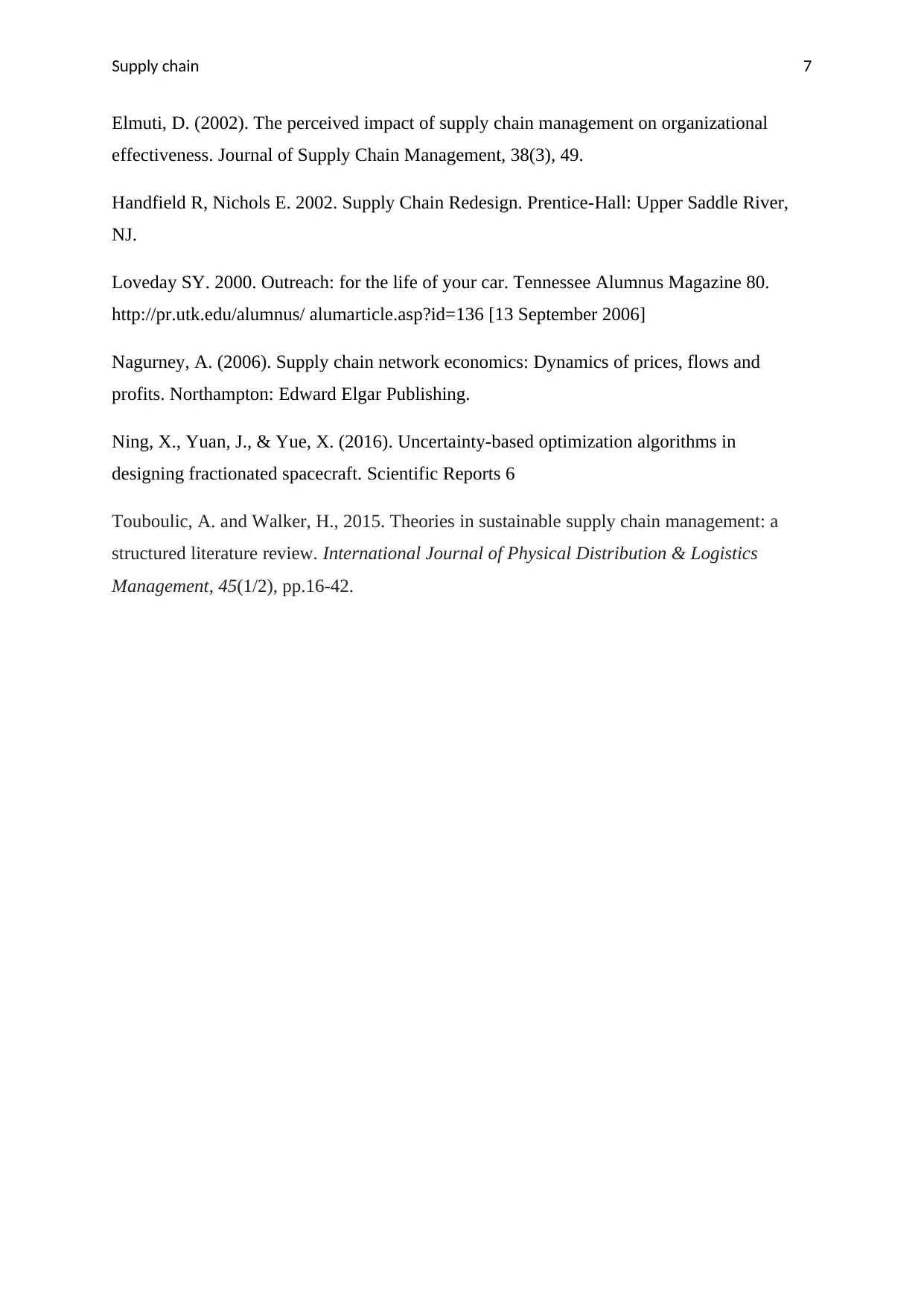
Supply chain 7
Elmuti, D. (2002). The perceived impact of supply chain management on organizational
effectiveness. Journal of Supply Chain Management, 38(3), 49.
Handfield R, Nichols E. 2002. Supply Chain Redesign. Prentice-Hall: Upper Saddle River,
NJ.
Loveday SY. 2000. Outreach: for the life of your car. Tennessee Alumnus Magazine 80.
http://pr.utk.edu/alumnus/ alumarticle.asp?id=136 [13 September 2006]
Nagurney, A. (2006). Supply chain network economics: Dynamics of prices, flows and
profits. Northampton: Edward Elgar Publishing.
Ning, X., Yuan, J., & Yue, X. (2016). Uncertainty-based optimization algorithms in
designing fractionated spacecraft. Scientific Reports 6
Touboulic, A. and Walker, H., 2015. Theories in sustainable supply chain management: a
structured literature review. International Journal of Physical Distribution & Logistics
Management, 45(1/2), pp.16-42.
Elmuti, D. (2002). The perceived impact of supply chain management on organizational
effectiveness. Journal of Supply Chain Management, 38(3), 49.
Handfield R, Nichols E. 2002. Supply Chain Redesign. Prentice-Hall: Upper Saddle River,
NJ.
Loveday SY. 2000. Outreach: for the life of your car. Tennessee Alumnus Magazine 80.
http://pr.utk.edu/alumnus/ alumarticle.asp?id=136 [13 September 2006]
Nagurney, A. (2006). Supply chain network economics: Dynamics of prices, flows and
profits. Northampton: Edward Elgar Publishing.
Ning, X., Yuan, J., & Yue, X. (2016). Uncertainty-based optimization algorithms in
designing fractionated spacecraft. Scientific Reports 6
Touboulic, A. and Walker, H., 2015. Theories in sustainable supply chain management: a
structured literature review. International Journal of Physical Distribution & Logistics
Management, 45(1/2), pp.16-42.
1 out of 8
Related Documents
Your All-in-One AI-Powered Toolkit for Academic Success.
+13062052269
info@desklib.com
Available 24*7 on WhatsApp / Email
![[object Object]](/_next/static/media/star-bottom.7253800d.svg)
Unlock your academic potential
Copyright © 2020–2025 A2Z Services. All Rights Reserved. Developed and managed by ZUCOL.



